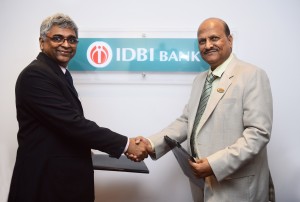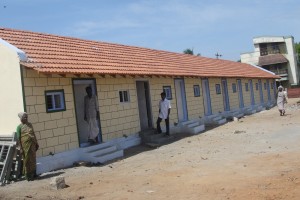National Housing Bank is an apex agency for the central government’s ambitious ‘Housing for All by 2022’ program. Sriram Kalyanaraman, MD and CEO, outlines the work his organization has in hand:

- Mohan: Can you outline the activities that you propose to undertake as the nodal agency for the implementation of Pradhan Mantri Awas Yojana? Do you think the target of disbursing Rs20,000 crore in 2015-16 is achievable?
Sriram Kalyanaraman: National Housing Bank is the central nodal agency for the implementation of the credit linked subsidy scheme under the Pradhan Mantri Awas Yojana. In the last few months, we have been able to lay down the necessary groundwork for quick and effective rollout of the scheme. We have entered into MoUs with 143 primary lending institutions, comprising a fair mix of housing finance companies, scheduled commercial banks and regional rural banks, and we have already received and processed subsidy claims from more than 40 institutions so far. We have also been holding regional workshops across the country to sensitize the staff of the lending institutions about the scheme and its requirements. To date, we have held 7 regional workshops and are in the process of organizing several more. As to our regular refinance we have already disbursed nearly Rs18,000 crore till 31 March 2016 and we are hopeful of achieving the targeted numbers by our year end, that is, June 2016.
How successful is NHB in creating resources for itself in order to meet the targeted loan disbursals?
As NHB is regulated by RBI, resource raising norms applicable to financial institutions govern us in creating resources. We have been able to completely avail the limit with a good mix of all instruments. There are both short term and long term borrowings from markets as well as from other financial institutions, both within India and abroad as well. From the domestic market some of the instruments through which we raise resources include commercial papers, bonds in the nature of debentures, term loans from banks/LIC. We have also availed lines of credit from bilateral institutions like Asian Development Bank, KfW, Germany and DFID, UK and also from multilateral institutions like the World Bank. In addition, we have received funds under the Rural Housing Fund and Fund for affordable Housing to Urban Poor/EWS/LIG (UHF). We have also mobilized deposits from public under two schemes – Sunidhi Term Deposit Scheme and Suvruddhi Term Deposit Scheme (Tax Savings under section 80c of Income Tax Act, 1961). As on 31 December 2015, our total borrowing outstanding was Rs 44,223 crore.
Can you talk about the target audience and what have been your experiences in meeting their needs?

Shriram Kalyanaraman
As you know, NHB is the apex housing financial institution in India and is mandated to promote and develop the housing and housing finance sector in the country. Since inception, we have been working to facilitate the supply of affordable housing for the ‘bottom of the pyramid’ (BoP). We provide equity and concessional loan assistance to mortgage lenders for increased home ownership among lower income households. To supplement the flow of credit, our refinance window provides retail lending institutions with an economical and efficient source of fund for their housing finance operations.
Today, we offer a range of refinance products aimed at fulfilling the needs of the various sub-segments of the market – from rural housing to urban low income housing and housing for women amongst others. We offer several products to the primary lending institutions at concessional rates as an incentive for them to extend long term fixed rate loans to the vast segments of the population in need of such support.
Further, to address the issue of availability of finance to those affected by natural calamities like cyclone, floods, earthquake etc, we have launched several dedicated refinance schemes in the past. These were refinance assistance for lending in the 1999 cyclone hit areas of Orissa, refinance scheme for housing in the 2001 earthquake affected districts of Gujarat and special refinance scheme for flood affected areas of Jammu & Kashmir. In the recent past, in order to assist the flood affected people in Tamil Nadu, we extended refinance at concessional rates to PLIs with an on-lending interest rate cap to beneficiaries.
We have also tied up with multilateral agencies like the World Bank and DFID for providing housing finance to low income households, especially to those deriving their income from the informal sector and to people in the low income states, thus facilitating financial inclusion across large segments of the population. Refinance scheme for urban low income housing envisages lending not only for informal income/occupation but also in informal tenure. Thus, we are breaking ground in promoting lending by PLIs to informal sector which was hitherto neglected by the formal financing institutions. World Bank, in partnership with us, decided to run a $100 million program in August 2013. This is a sort of pilot which may be scaled up worldwide. Under this program 55% of the lending would be under formal tenure and 45% under informal tenure. Till date disbursements of more than Rs300 crore have been made.
Under the Energy Efficient Refinance Scheme, in partnership with KfW, Germany, we made disbursements of more than Rs 400 crore.
We have been lending under Rural Housing Fund (RHF) since 2008-09 and the total disbursements under this stood at Rs23720 crore with Rs2540 crore being disbursed in the current year. Similarly, under the Urban Housing Fund (UHF) we have made a total disbursement of Rs5900 crore since 2013-14 Both RHF and UHF were announced by the government of India for making available low cost – long term housing finance to economically weaker section of the population with fixed interest rates.
NHB has a role in regulating the activities of housing finance companies in the country. Can you list some of the major decisions taken in this regard in the past couple of years?
Some of the major regulatory developments in the last few years are:
- As an important step to bring in greater commitment to the housing finance business, we increased the
 requirement of minimum NOF of HFC from the earlier level of 2 crore to 10 crore to be eligible to commence or carry on the business of an HFI in June 2011.
requirement of minimum NOF of HFC from the earlier level of 2 crore to 10 crore to be eligible to commence or carry on the business of an HFI in June 2011. - The number of housing finance companies registered with us has grown from 52 as of 30 June 2011 to 71 presently.
- We have developed a Grievance Registration & Information Database System (GRIDS), a 24×7 on-line database system, which facilitates mainly the customers of HFC to lodge a complaint, and also track its status. GRIDS enables instant on-line updating of response to a complaint by HFC/NHB and also facilitates in viewing the latest status at any time by the complainant/HFC/NHB from a centralized database. This has helped not only in bringing about transparency in grievance redressal mechanism, but also in reducing turnaround time on the disposal of complaints.
- We have issued directions to HFCs on issuance of non-convertible debentures on private placement basis, which need to be complied by HFCs while issuing NCDs.
- With a view to promoting transparency in the operations of HFCs, we have issued guidelines on fair practices code to HFCs. Further, they have also been advised to obtain a document containing the Most Important Terms and Conditions (MITC) of housing loans extended by them as a part of the loan agreement to be executed between the HFC and the borrower and also to display the information adequately in their Branches/Offices as well as on their website.
- We issued the guidelines for entry of HFCs into insurance business permitting these HFCs to set up joint ventures for undertaking insurance business with risk participation and also to undertake insurance business as agent of insurance companies.
- As a measure of customer protection and also in order to bring in uniformity with regard to prepayment of various loans by borrowers of banks, NBFCs and HFCs, we have advised HFCs not to charge foreclosure charges/pre-payment penalties on all floating rate term loans sanctioned to individual borrowers.
- We have also made it mandatory that all HFCs need to contribute to all the credit bureaus.
- To provide fillip to ‘Housing for All’, especially to those falling under LIG and MIG segments, we reduced the risk weight for individual housing loans up to Rs75 lakh. The minimum risk weight for individual housing loans has been reduced from 50% to 35% depending on Loan to Value (LTV) ratio.
Can you elaborate on the refinancing activities in the last two financial years?
Our refinance assistance to the primary lending institutions (PLIs) has been steadily growing over the past few years. During 2013-14, refinance disbursements aggregated to Rs17,856 crore. This went to Rs21,847 crore in 2014-15 which was an increase of 22.35% yoy. Of the total disbursement, approximately 22.52% was made towards rural housing. Further, approximately 53.62% of the total disbursements or Rs11,714 crore was made against loans under Rs15 lakh and out of this Rs11,714 crore, Rs3407 crore were made towards loans under Rs5 lakh.
During the last 2 years, we have launched 2 new schemes i) urban low income housing refinance scheme and (ii) refinance scheme for construction finance for affordable housing. Also, we have earmarked assistance for flood affected people of J&K and Tamil Nadu.
The bank is also providing direct finance under project finance? Which are the major beneficiaries in this segment?
In terms of Section 14 (ba) of the National Housing Bank Act 1987, we extend financial assistance through our project finance window to various public agencies like state housing boards, state slum clearance boards/authorities, development authorities, municipal corporations, etc for undertaking residential housing. Our endeavour is to facilitate increase in the overall housing stock in the country through supply side intervention with special emphasis on the housing needs of the weaker sections of the society. Financial assistance is extended to commercially viable project in terms of our project finance policy and in line with the guidelines prescribed by the RBI.
Can you discuss the salient aspects of your securitization program and the success stories?
We have so far completed 14 residential mortgage backed securitization (RMBS) transactions involving 38,809 individual housing loans of six HFCs and one scheduled commercial bank amounting to Rs862.20 crore. The success of the issues of RMBS has significantly provided means to better understand and address the various legal, regulatory, fiscal, accounting and other capital market related issues relating to such transactions as also various policy issues for a conducive environment for such issuances. The structure of RMBS issues has been designed under the provisions of the National Housing Bank Act, 1987 which authorize the bank to carry out securitization transactions and issue mortgage backed securities as trust certificates of beneficial interest and act as Trustee for the holders of such securities.
RBI has recently brought in Rs 1000 crore into NHB. How would you be making use of these funds?
RBI has infused this capital in February 2016 and this will help us in leveraging to the tune of Rs10,000 crore for meeting additional disbursements to facilitate the HFCs and banks to lend more towards housing thereby enabling the fulfillment of housing for all goal.
the fulfillment of housing for all goal.
Can you talk about the central government program of Housing for All by 2022 and the significant role that is envisaged for NHB in this?
The Housing for All Program is a major initiative of the government and is expected to fully achieve its objective in view of its multi-pronged approach. The program has four components – (i) rehabilitation of slum dwellers with participation of private developers using land as a resource, (ii) promotion of affordable housing for weaker sections through credit linked subsidy, (iii) affordable housing in partnership with public and private sectors (a supply side initiative), and (iv) subsidy for beneficiary-led individual house construction. We have been appointed as a central nodal agency for implementing the Credit Linked Subsidy Scheme, under which interest subsidy of 6.5% p.a. for loans up to a certain amount will be provided to households belonging to the economically weaker sections and lower income groups. A notable feature of this scheme is that the property should be in the name of the female head of the household, though joint ownership with the male head of household has also been permitted. This is expected to provide a major boost to women empowerment. We have entered into MoUs with more than 140 mortgage lending institutions and started disbursing the subsidy claims.
The government has also taken a number of initiatives in the recent union budget aimed towards development of the housing sector in the country. The proposal to give 100% deduction for profits to developers from their housing projects of up to 30 sq. mtr. in metros and 60 sq. mtr. in other places would certainly encourage the developers to look at this segment anew. Further, the proposals to exempt affordable houses of up to 60 sq. mtr. under any scheme of the central and state governments, including PPP schemes, from service tax, and the proposal to provide additional deduction of Rs50,000 to first time home buyers would further improve affordability in the hands of the end consumer. The recently passed Real Estate (Regulatory and Development) Bill is a groundbreaking piece of legislation which would propel the real estate industry to a new plane altogether by bringing in more transparency and disclosures through a framework for reducing conflict.
Finally, as an apex institution for housing, what are your long terms plans to bridge the gap between demand and supply in the housing sector – urban as well as rural – in the country given the fact that it is a challenging task indeed?
According to the report of the Technical Group (TG-12) on Estimation of Urban Housing Shortage, the total urban housing shortage in the country in 2012 recorded a decline from 24.71 million at the beginning of 11th Five Year Plan as estimated by 11th Plan Technical Group to 18.78 million in the beginning of the 12th Plan as estimated by TG-12. But it is still a staggering figure. On the rural side, as estimated by the working group on rural housing for the 12th Five-Year Plan, the estimated rural housing shortage in India is 43.13 million in 2012. There is a gap between the demand and supply of housing (both in terms of quantity and quality). A key constraint to affordable housing to the poor is the lack of adequate flow of formal credit to the segment at affordable interest rates. This has resulted in a huge shortage of housing for these segments, and a multi-pronged effort is required to address the problem in all its dimensions. Facilitating and catalyzing the credit flow in the housing sector and support the expansion in home ownership in the country is NHB’s vision.
Our long term goals are:
- We would work in tandem with the government of India for implementation of PMAY which aims for “Housing for All” by 2022.
- We would refinance new HFCs which are entering the housing finance sector, particularly catering to the rural and urban low income households.
- We are in the final stages of a product development for lending to the micro finance institutions (MFIs).
- We are also looking at the participating in the promotion of new HFCs through equity support.







